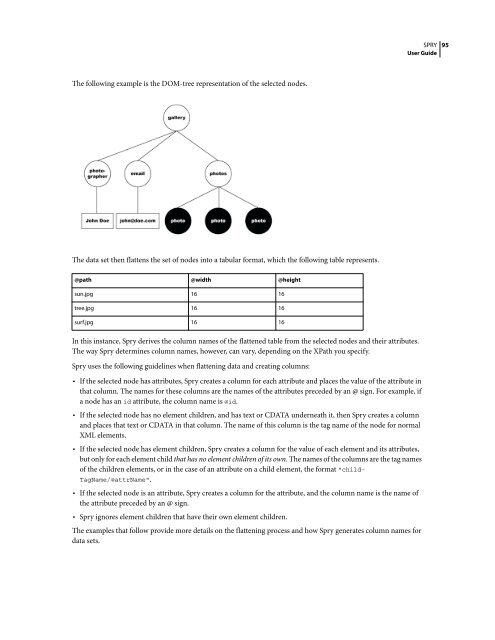Spry User Guide - Support - Adobe
Spry User Guide - Support - Adobe
Spry User Guide - Support - Adobe
You also want an ePaper? Increase the reach of your titles
YUMPU automatically turns print PDFs into web optimized ePapers that Google loves.
The following example is the DOM-tree representation of the selected nodes.<br />
The data set then flattens the set of nodes into a tabular format, which the following table represents.<br />
@path @width @height<br />
sun.jpg 16 16<br />
tree.jpg 16 16<br />
surf.jpg 16 16<br />
In this instance, <strong>Spry</strong> derives the column names of the flattened table from the selected nodes and their attributes.<br />
The way <strong>Spry</strong> determines column names, however, can vary, depending on the XPath you specify.<br />
<strong>Spry</strong> uses the following guidelines when flattening data and creating columns:<br />
SPRY<br />
<strong>User</strong> <strong>Guide</strong><br />
• If the selected node has attributes, <strong>Spry</strong> creates a column for each attribute and places the value of the attribute in<br />
that column. The names for these columns are the names of the attributes preceded by an @ sign. For example, if<br />
a node has an id attribute, the column name is @id.<br />
• If the selected node has no element children, and has text or CDATA underneath it, then <strong>Spry</strong> creates a column<br />
and places that text or CDATA in that column. The name of this column is the tag name of the node for normal<br />
XML elements.<br />
• If the selected node has element children, <strong>Spry</strong> creates a column for the value of each element and its attributes,<br />
but only for each element child that has no element children of its own. The names of the columns are the tag names<br />
of the children elements, or in the case of an attribute on a child element, the format "child-<br />
TagName/@attrName".<br />
• If the selected node is an attribute, <strong>Spry</strong> creates a column for the attribute, and the column name is the name of<br />
the attribute preceded by an @ sign.<br />
• <strong>Spry</strong> ignores element children that have their own element children.<br />
Theexamplesthatfollowprovidemoredetailsontheflatteningprocessandhow<strong>Spry</strong>generatescolumnnamesfor<br />
data sets.<br />
95















